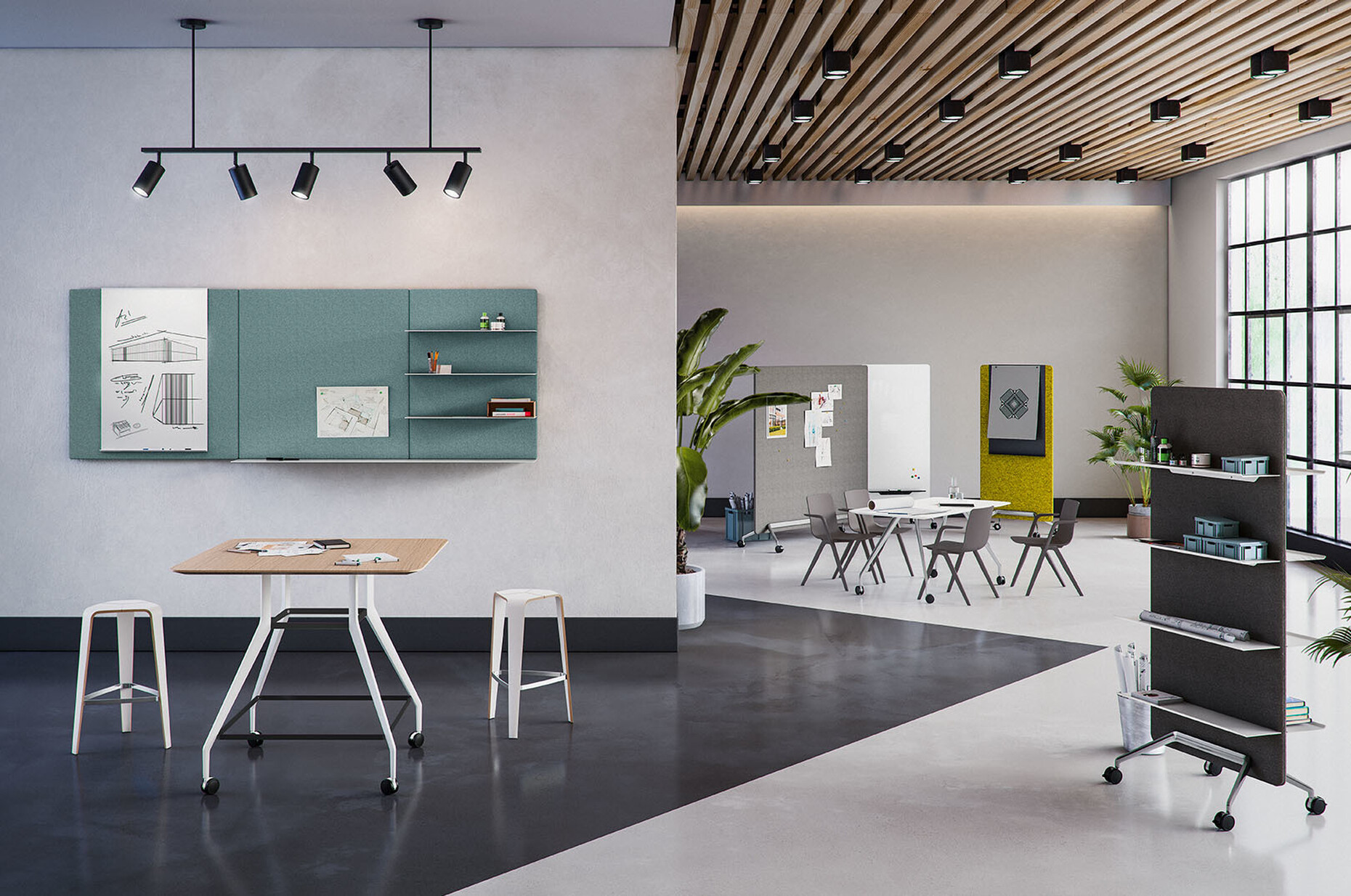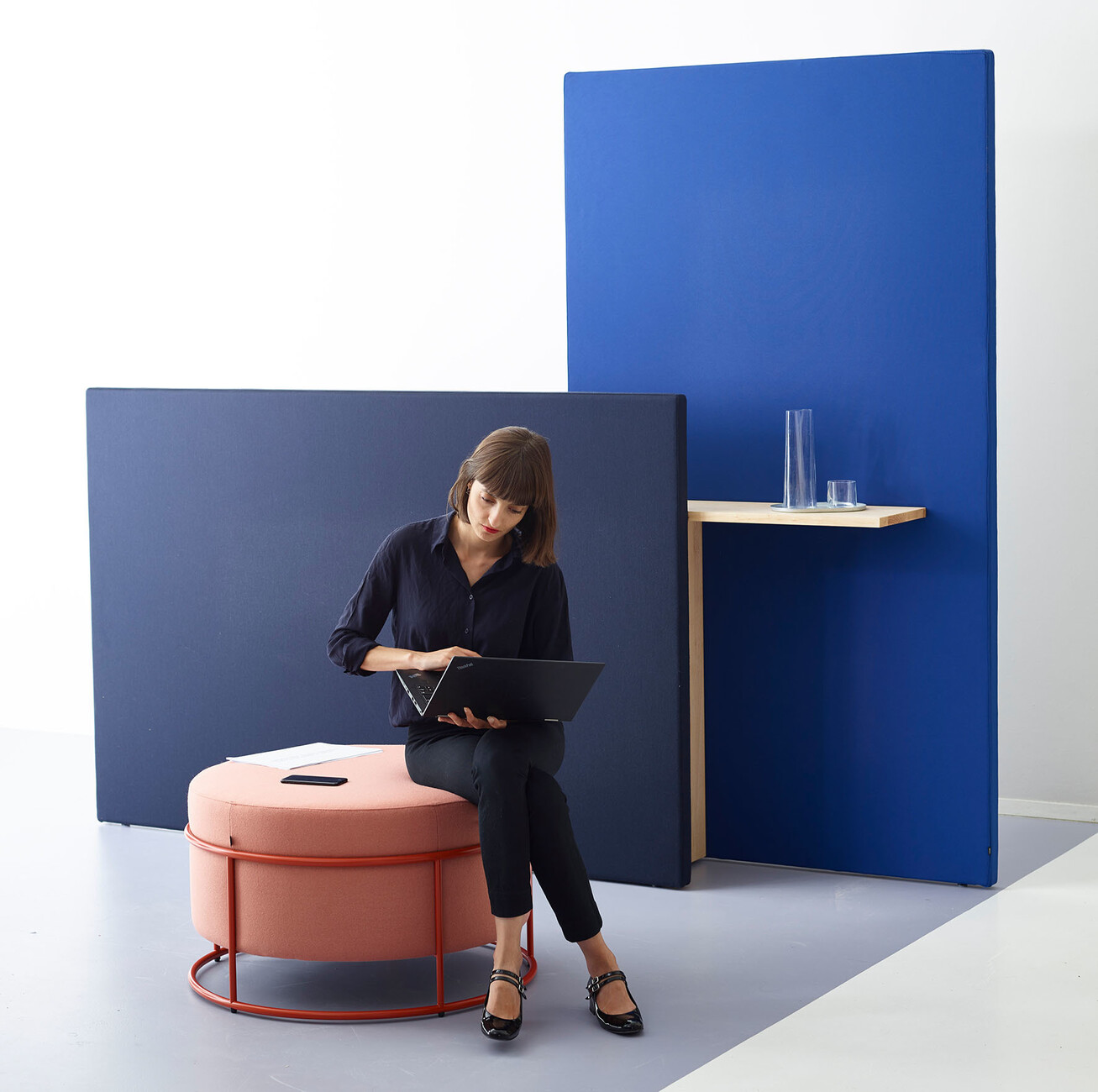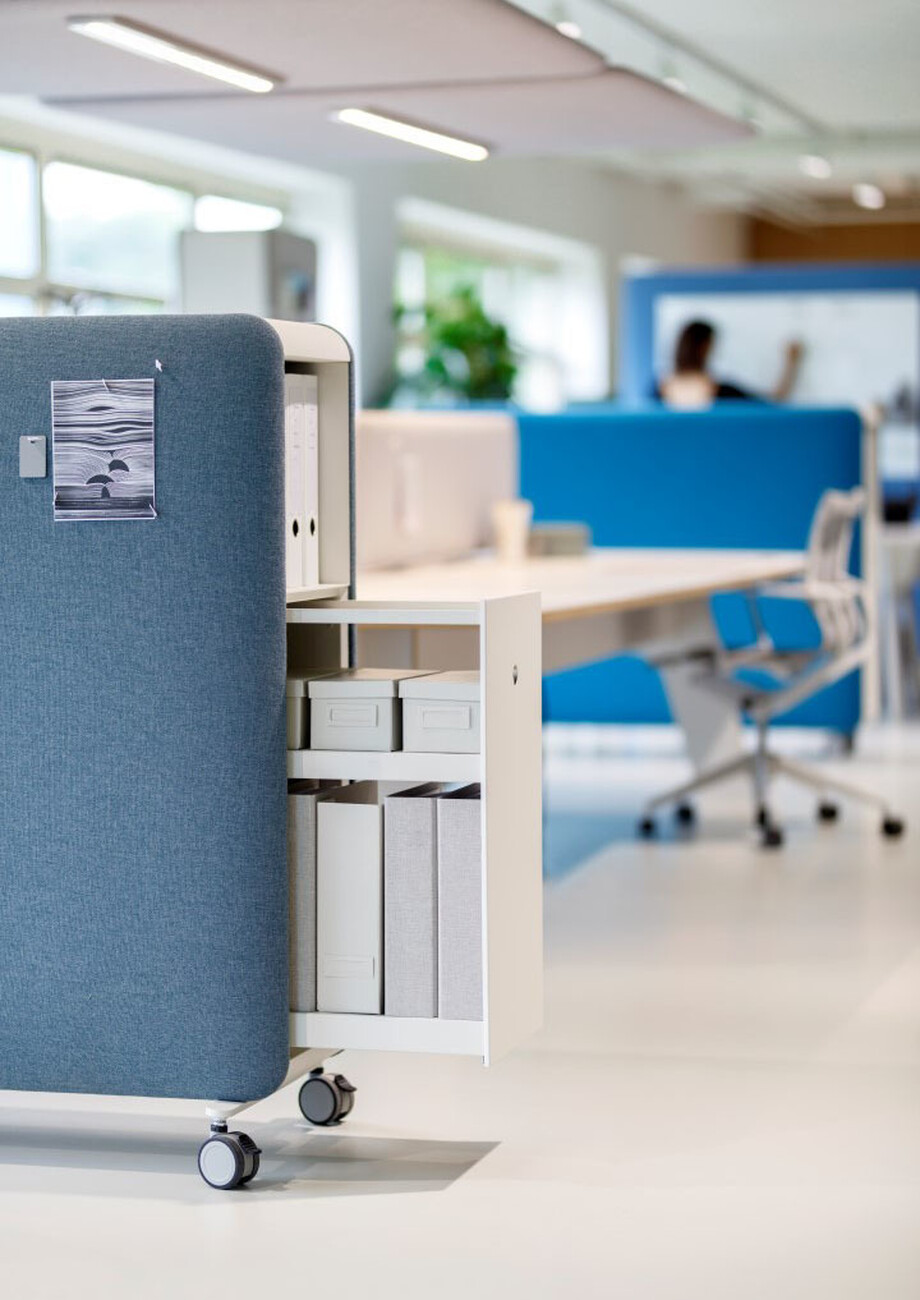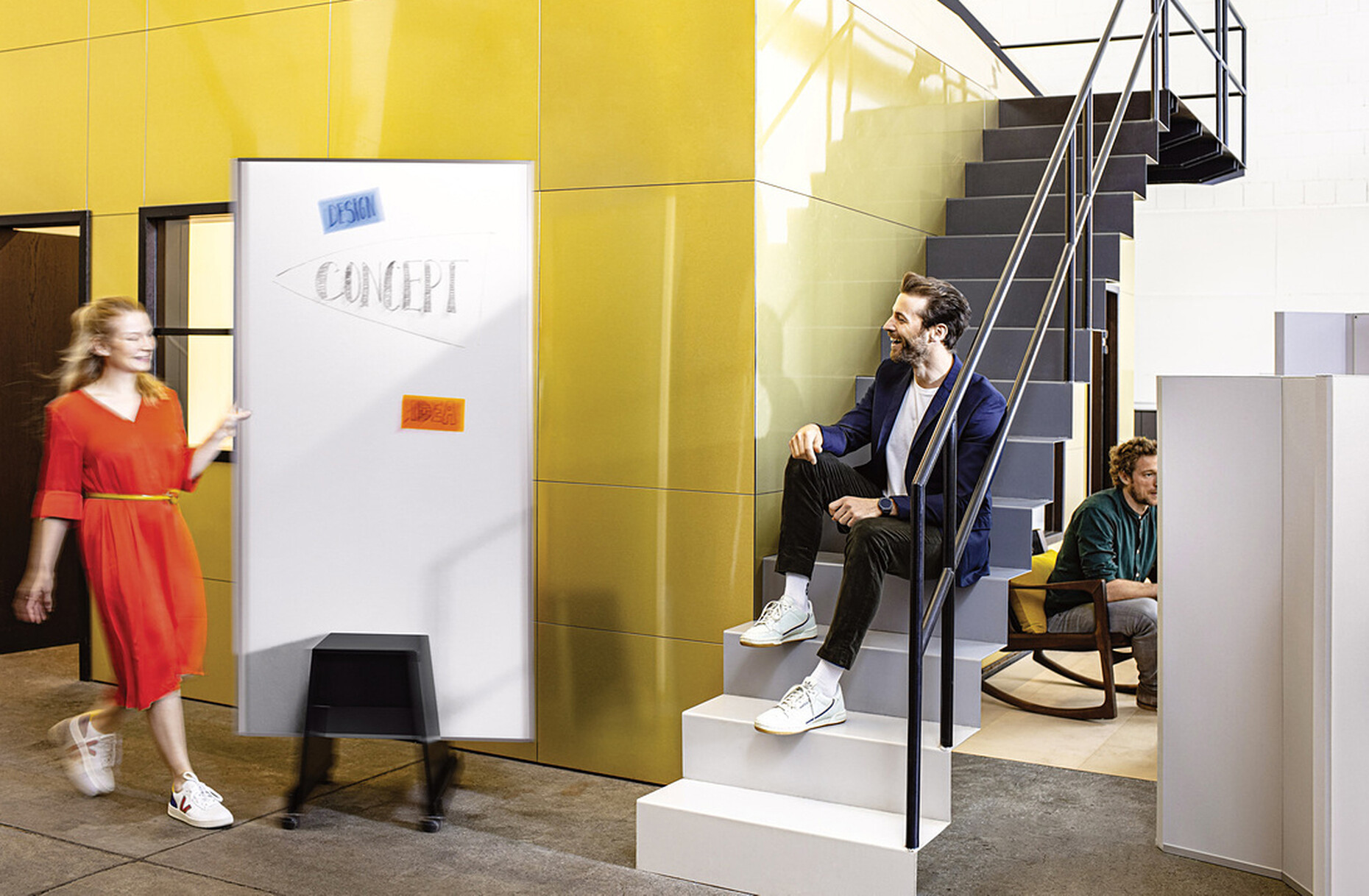Stylish separation
For many weeks things were quiet in the office world, and now the big shake-out has begun: New concepts are needed to ensure those who have now come back to the office can work safe and soundly. Maintaining social distancing to protect yourself and others against Covid-19 is the order of the day, but that really isn’t as simple as it sounds. Prior to Corona, open-plan offices were all the rage, and most of them afforded few opportunities to retreat to work in peace and quiet. In many places, the new temporary solutions entail predefining routes to walk, reducing the number of desks, and stacking the furniture that is no longer being used in corners. Yet what is actually called for are ideas that will work long-term and yet remain flexible. Going back to the days of single or twin-cell offices will hardly be the solution for team-oriented work. Instead, going forward the focus should shift to the great selection of dividing screens and whiteboards available on the market: They can be customized, are mobile, and safely separate workstations from one another, without disseminating the feeling that everything is about to be relocated that we tend to associate with panes of Perspex or stacks of books. And as wall-mounted versions they can help us keep to the necessary distancing and hygiene rules during presentations.
1. “Paravan” by Lievore Altherr for Arper
With its “Paravan” room divider modules, Arper is reducing ambient noise and bringing a lot of movement into the office – by offering various different outline shapes and colors. The panels optionally come with rounded edges to make divisions seem softer. And there are countless accessories from the collection "Paravan Mood" to help you personalize your screen, such as a magazine rack and table panel, through to an electric socket stack and a whiteboard.
2. “team” by Brunner
The textile surfaces of Brunner’s “team” room divider system can be swiftly and smoothly supplemented to include any function that is required in the office. “team” can be practically configured given a range that extends from pinboards and flipcharts through to shelves and whiteboard panels, and saves space into the bargain.
3. “Chart” by RelvãoKellermann for COR
"Chart is neither a wall, nor a shelf, let alone a room divider,” comments Ana Relvão of RelvãoKellermann. For COR the creative duo has conjured up a customizable system that essentially consists of a combination of room divider, sound screens and shelving system. The basis is formed by two upholstered screens that are set parallel to each other, whereby the gap between them and the outer surfaces can be used at will.
4. “Dancing Walls” by Stephan Hürlemann for Vitra
Mobile walls that can function optionally as room dividers, whiteboards, pinboards, shelves, or as a monitor trolley, clotheshorse or plant trolley: That is the idea behind Stephan Hürlemann’s “Dancing Walls” for Vitra. “In the manner of pop-up stores, the ‘Dancing Walls’ let you construct precisely the room you happen to need at that moment,” comments Hürlemann himself. The basis is formed by a metal frame that is then outfitted to meet the desired function and which can be swiftly adapted to new requirements without any assembly being needed.
5. “Hub” by Interstuhl
The new “Hub” furniture and room-dividing system by Interstuhl comprises not only furniture and pods for meetings, but also dividing screens based on aluminum profiles that can be expanded to include media racks and whiteboards. The “Hub Board” stands on four castors and can be pulled by leather loops into any position required. Whiteboards and other utensils such as headsets can be swiftly stored/hung from hooks.
6. “gumpo flipchart” by Relvãokellermann for gumpo
“Normcore” is the name of the screen system Ana Relvão and Gerhardt Kellermann developed for gumpo, and this includes the “gumpo flipchart”. The overall image is defined by a reduced and clear formal vocabulary. Two vertical panels and one horizontal slat combine to form the structure and provide shelving space. Castors make the flipchart duly mobile. The room dividing system “backdrop” is moreover noise-absorbent and thus ideal for structuring work-zone islands.
7. “Screens” by Steelcase
Steelcase’s “Flex Collection” includes “Screens” – light, mobile room dividers that can be fastened to each other thanks to their magnetic edges. The “Screens” are available in three sizes and shapes, giving you countless options for subdividing rooms into zones. Notes can simply be fastened by tacks to the textile surface.
8. “Pillow Space” by Cascando
Robert Bronwasser designed the “Pillow Space” for Cascando with the intention of providing a mobile room divider that optimizes ambient acoustics with its foam upholstery on the front and back. The indents on both narrow sides with their small shelves can be used at will for any manner of accessories – from clothes hooks and brochure racks or clothes rails to proper shelves or planters. Different sizes and a broad range of colored fabrics provide great scope for dividing up your office space anew.
9. “Pin Up on Tour” by Roomours
Room divider, pinboard, chalkboard or whiteboard: "Pin Up on Tour" by Roomours combines several options in a single product. The board comes with two surfaces: one side is covered in felt, and you can simply tack notes onto it. The back is made of powder-coated metal and is therefore magnetic, can be dry-wiped and is ideal for board markers. The castors mean “Pin Up on Tour” is flexible, and the frame made of oiled oak gives the unit an elegant appearance overall.
10. “Meet up” by Sigel
Sigel’s mobile “Meet up” boards system boasts a compact design and two work surfaces in a single unit: The magnetic whiteboard and the pinboard can be used simultaneously. Depending on your needs, “Meet up” comes on castors to act as a flexible and functional room divider, or can be slotted into a track on the wall to save space. In the standalone version, the boards can, for example, be supplemented with Sigel’s “Sound Balance” acoustic elements to lower noise levels in the space, whereby the pared-back design ensures the unit discretely takes a back seat.
































